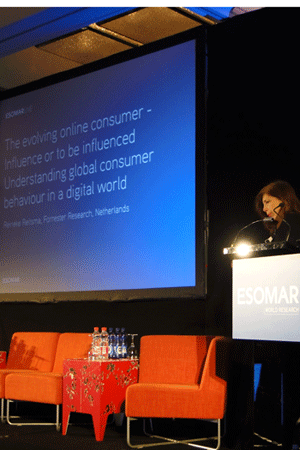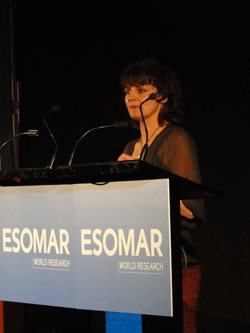Contributing Blogger – Sue Nosworthy, Past Vice President ESOMAR

Following the customary caffeine break, Reineke Reitsma from Forrester, Netherlands spoke to us about the evolving global on-line consumer. “Numbers only tell part of the story…Opportunity isn’t obvious anymore and because of this we have a dire need for insights in global shopping behaviors”. She told us that by 2014, one-third of the global on-line population will come from the BRIC countries – even today, China is second only to the US in terms of numbers of consumers buying on-line.
One of the drivers of globalisation is the update of the internet – Forrester predicts this growth to be stronger in emerging markets … In 2040 1/3 of internet population will live in BRIC countries … China has 108 million shoppers but in 2015 they will have an estimated 278 million … Chinese consumers under 30 spend 3x more time on the internet versus the TV – a real market for online TV! Unilever attracted more than 100 million views from their internet-only TV drama based on the fictional life of a Chinese character who worked in PR for Clear Shampoo – a real Unilever product. Now, that is understanding your consumer and grabbing their attention!
Reineke also talked about the difficulties of extracting insights from the increasingly large amounts of data available, and the importance of cultural context. Bottom line – we must move past our limited world view if we are to really understand global shopper behavior … William James once said “the art of being wise is to know what to overlook” with all the data out there … do you know how to overlook to get insights?

Danielle Pinnington, from Shoppercentric in the UK, then talked about the new shopper journey touchpoints. She told us how shoppers are evolving – they are now in charge – and retailers and manufacturers are struggling to keep up. Two key trends are influencing this – the first of these is social networking and the second of these is mobile communications. As these converge they put the shopper ever more firmly in control – Danielle gave an excellent example of a shopper using a phone app to check prices and then negotiate for the same price in store.
With regard to social networking, there is evidence that not all brands and retailers are getting it right – many consumers can’t see the point of businesses using social networking. Danielle encouraged both retailers and brands to go back to basics with regard to use of social media – to understand what consumers want from that space, and to learn how to work in it. The most successful brands will be those which are most relevant, conversing with consumers in their language, and which offer a genuine benefit – be that social or economic. Above all, having a Facebook page is not just about selling, it is all about finding ways to engage the consumer – using the language of conversations that is appropriate to the medium.
Leyla Namiranian then handed over chairmanship of the sessions to Karin Bruyr, Director Market Intelligence, Telenet Belgium, and the newly appointed ESOMAR representative for the Belgian market. Karin introduced the “Validating Insights” section of the programme , and to lead off this section she introduced Sven Diekmann from eye square, Germany.

Sven presented a new methodology that generates 3D visualizations of eye-tracking and locomotion studies. Through these visualizations, eye square have produced what they call the ARC model of shopper behavior: Awareness, Relevance, Consideration/Choice.
Using information collected from over 1,000 respondents and 14 different studies, Sven presented three golden rules for in/store marketing:
1) Awareness: Guide the shopper and Prime the shopper! It is clear that shoppers do not pay clear attention to the usual in-store signage, so we must ensure that we use other/innovative measures to guide them clearly!
2) Relevance: Make sure there is clear category and sorting structure, and that Point of Purchase Material is clearly and coherently placed, and..
3) Consideration: Ensure that the consumer is constantly reassured that their choice is the right one!
Perhaps for many, these three golden rules appear to be re-stating the obvious, but it is clear from eye square’s work that these three elements are often missing!!
Sven was then followed by Stephanie Grootenhuis, Kraft Foods International, who focused not on the challenge of obtaining insights but rather on the challenges of communicating those insights in a global organisation of 150,000 employees. She described a system they had developed within Kraft, together with their partners 4Dshopper, to communicate the findings of their research involving virtual shopping and eye-tracking, to a number of internal and external audiences. The key elements were, super-simplicity, works for all retail formats, across regions, across audiences and fun and flexibility. So far, the results have been impressive – generating a lot of enthusiasm among those who have seen it and a desire for more information! Maybe there are some lessons in there for those of us on the supplier side as we prepare our client presentations.



